| Article ID | Journal | Published Year | Pages | File Type |
|---|---|---|---|---|
| 1294379 | Journal of Power Sources | 2008 | 9 Pages |
Abstract
Bismuth oxide based oxygen ion conductors are incorporated into (La,Sr)MnO3 (LSM), the classical cathode material for solid oxide fuel cells (SOFC), to improve the cathode performance. Yttria-stabilized bismuth oxide (YSB) is taken as an example and is impregnated into a preformed porous LSM frame, forming a highly active cathode for intermediate-temperature SOFCs (IT-SOFCs) with doped ceria electrolytes. X-ray diffraction indicates that YSB is chemically compatible with LSM at intermediate temperatures below 800 °C. The impregnated YSB particles are nanosized and are deposited on the surface of the framework. Significant performance improvement is achieved by introducing nanosized YSB into the LSM electrodes. At 600 °C, the interfacial polarization resistance under open-circuit conditions for electrodes impregnated with 50% YSB is only 1.3% of the original value for a pure LSM electrode. The resistance is further reduced dramatically when current is passed through. In addition, the YSB impregnated LSM electrodes has the highest electrochemical performance among those based on LSM. Single cell with 25% of YSB impregnated LSM cathode generates maximum power density of 300 mW cmâ2 at 600 °C, indicating the promise of using LSM-based electrodes for IT-SOFC.
Related Topics
Physical Sciences and Engineering
Chemistry
Electrochemistry
Authors
Zhiyi Jiang, Lei Zhang, Kai Feng, Changrong Xia,
